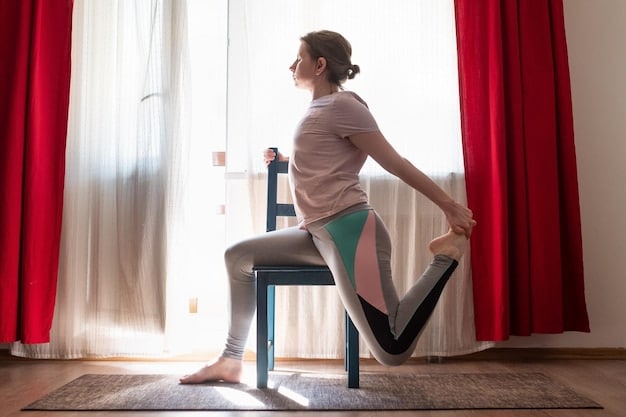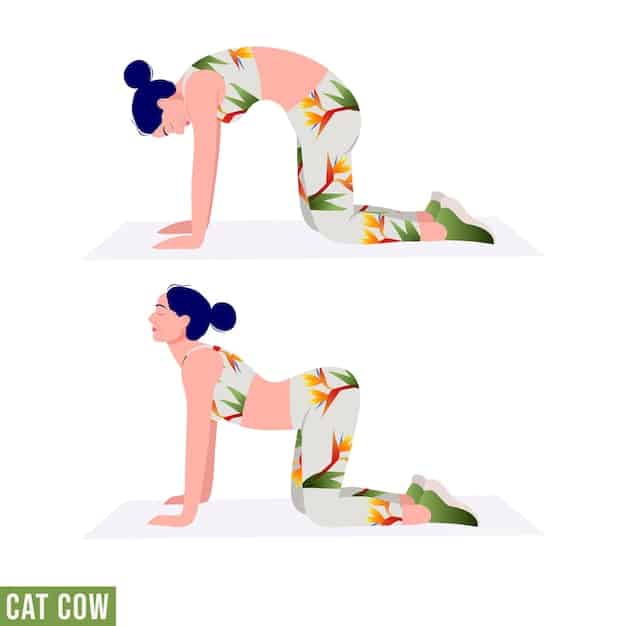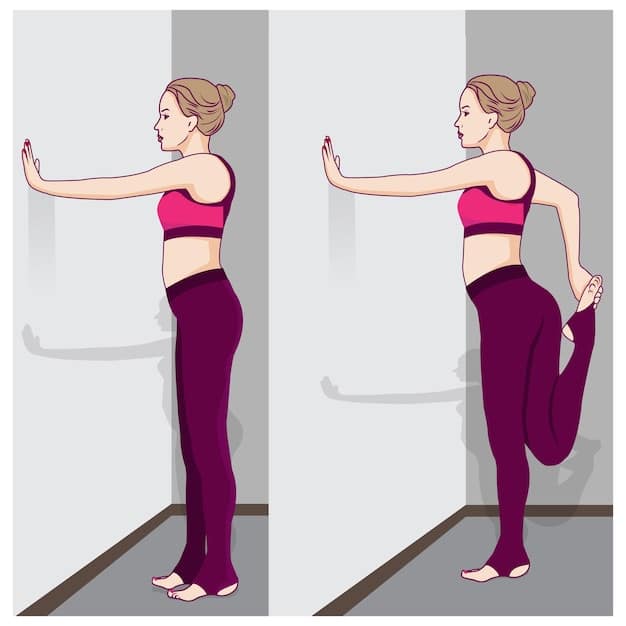7 Simple Stretches for Back Pain Relief and Better Posture

Discover seven simple yet effective stretches that can significantly relieve back pain and improve your posture, helping you maintain a healthier and more comfortable lifestyle.
Are you experiencing persistent back pain or struggling with poor posture? You’re not alone. Many people suffer from these issues due to sedentary lifestyles, prolonged sitting, or incorrect lifting techniques. Fortunately, incorporating simple stretches into your daily routine can provide significant relief. Here are 7 simple stretches to relieve back pain and improve posture, offering a natural and effective solution for a healthier spine.
Understanding Back Pain and Posture
Back pain and poor posture are often intertwined, creating a cycle of discomfort and potential long-term health issues. Understanding the root causes of these problems is the first step toward finding effective solutions. Let’s delve into the common culprits and the impact they have on your overall well-being.
Common Causes of Back Pain
Back pain can stem from a variety of factors, ranging from lifestyle habits to underlying medical conditions. Identifying the specific cause of your back pain is crucial for addressing it effectively. Here are some frequent contributors:
- Sedentary Lifestyle: Spending long hours sitting without regular movement can weaken your back muscles and lead to stiffness and pain.
- Poor Ergonomics: Incorrect posture while sitting, standing, or lifting objects can strain your back and contribute to chronic pain.
- Muscle Strain: Overexertion or sudden movements can cause muscle strains or sprains in the back, resulting in acute pain.
- Underlying Conditions: In some cases, back pain may be a symptom of underlying conditions such as arthritis, disc problems, or spinal stenosis.
The Importance of Good Posture
Good posture is more than just standing up straight. It involves maintaining the natural curves of your spine and aligning your body in a way that minimizes stress on your muscles and joints. The benefits of good posture extend beyond aesthetics, impacting your overall health and well-being.
- Reduces Back Pain: Proper alignment reduces strain on your back muscles, minimizing the risk of pain and discomfort.
- Improves Breathing: Good posture allows your lungs to expand fully, improving breathing efficiency and oxygen intake.
- Boosts Confidence: Standing tall with good posture can enhance your self-esteem and project confidence.
- Prevents Fatigue: Maintaining good posture requires less effort from your muscles, reducing fatigue and improving energy levels.
By understanding the causes of back pain and the importance of good posture, you can take proactive steps to improve your spinal health and overall quality of life. The following stretches are designed to target these issues, providing relief and promoting better alignment.

Stretch 1: Cat-Cow Stretch
The Cat-Cow stretch is a gentle and fluid movement that improves spinal flexibility, relieves back pain, and promotes relaxation. It alternately flexes and extends the spine, increasing circulation to the discs and vertebrae. This stretch is particularly beneficial for those who spend long hours sitting or experience stiffness in their back.
How to Perform the Cat-Cow Stretch
Performing the Cat-Cow stretch correctly is essential to maximize its benefits and avoid potential injury. Follow these steps for proper execution:
- Start on your hands and knees, with your hands directly under your shoulders and your knees under your hips.
- Inhale deeply and move into the “Cow” position. Drop your belly towards the floor, arch your back, and lift your head and tailbone towards the ceiling.
- Exhale and move into the “Cat” position. Round your spine towards the ceiling, tuck your chin to your chest, and draw your tailbone inward.
- Continue alternating between the Cat and Cow positions, coordinating your movements with your breath.
Benefits of the Cat-Cow Stretch
Regularly performing the Cat-Cow stretch offers numerous benefits for your spinal health and overall well-being:
- Increases Spinal Flexibility: The fluid movements enhance the range of motion in your spine, reducing stiffness and improving mobility.
- Relieves Back Pain: The stretch helps to release tension in the back muscles, alleviating pain and discomfort.
- Promotes Relaxation: The coordinated breathing and gentle movements have a calming effect on the mind and body, reducing stress and promoting relaxation.
By incorporating the Cat-Cow stretch into your daily routine, you can improve your spinal health, relieve back pain, and enhance your overall well-being. Aim for 5-10 repetitions, moving slowly and mindfully with your breath.
Stretch 2: Child’s Pose
Child’s Pose is a restorative yoga posture that gently stretches the lower back, hips, and ankles while promoting relaxation and stress relief. It’s an excellent stretch for relieving tension and calming the mind. This pose can be particularly helpful after prolonged sitting or standing.
How to Perform Child’s Pose
To properly execute Child’s Pose, follow these simple steps:
- Start on your hands and knees, with your knees hip-width apart and your big toes touching.
- Sit back on your heels and gently lower your torso between your thighs.
- Extend your arms forward, palms facing down, and rest your forehead on the floor. If your forehead doesn’t reach the floor, you can use a pillow or blanket for support.
- Relax your shoulders and allow your body to sink into the pose. Breathe deeply and hold for 30 seconds to a few minutes.
Benefits of Child’s Pose
Child’s Pose offers several physical and mental benefits, making it a valuable addition to your stretching routine:
- Relieves Lower Back Pain: It gently stretches the lower back muscles, releasing tension and alleviating pain.
- Calms the Mind: The pose promotes relaxation and reduces stress, helping to calm the mind.
- Stretches Hips and Ankles: Child’s Pose provides a gentle stretch to the hips and ankles, improving flexibility and mobility.
Incorporating Child’s Pose into your daily routine can help alleviate back pain, reduce stress, and improve overall well-being. Spend a few minutes in this pose whenever you feel tension or discomfort in your back.
Stretch 3: Knee-to-Chest Stretch
The Knee-to-Chest stretch is a simple yet effective exercise for relieving lower back pain and improving flexibility in the hips and hamstrings. It involves gently pulling one or both knees towards the chest to stretch the muscles in the lower back and hips.
Performing the Knee-to-Chest Stretch
The Knee-to-Chest Stretch is simple to execute and can easily be incorporated into your daily routine. Here’s how to do it correctly:
- Lie on your back with your knees bent and feet flat on the floor.
- Gently pull one knee towards your chest, using your hands to clasp your leg.
- Hold the stretch for 20-30 seconds, breathing deeply and relaxing your back.
- Repeat on the other side. For a deeper stretch, pull both knees towards your chest simultaneously.
Benefits of the Knee-to-Chest Stretch
Regularly performing the Knee-to-Chest Stretch can provide several benefits for your lower back and overall flexibility:
- Relieves Lower Back Pain: It helps to release tension in the lower back muscles, reducing pain and discomfort.
- Improves Hip Flexibility: This stretch increases flexibility in the hips, making it easier to move and perform daily activities.
- Stretches Hamstrings: The Knee-to-Chest Stretch also provides a gentle stretch to the hamstrings, improving flexibility in the back of the legs.
Add the Knee-to-Chest Stretch to your stretching routine to relieve lower back pain, improve hip flexibility, and maintain a healthy spine. Aim for 2-3 repetitions on each side, holding each stretch for 20-30 seconds.
Stretch 4: Spinal Twist
Spinal twists are an excellent way to improve spinal mobility, relieve back pain, and promote detoxification. These stretches involve rotating the torso, which helps to release tension in the back muscles and improve circulation. Spinal twists can be performed in a variety of positions, including seated, supine, and standing.
How to Perform a Seated Spinal Twist
A seated spinal twist is a gentle and accessible way to stretch your back and improve spinal flexibility. Here’s how to do it properly:
- Sit on the floor with your legs extended in front of you.
- Bend your knees and place your feet flat on the floor.
- Place your right hand behind you for support and bring your left foot to the outside of your right knee.
- Inhale to lengthen your spine and exhale as you twist your torso to the left.
- Place your left hand on your right knee or thigh.
- Hold the twist for 20-30 seconds, breathing deeply. Repeat on the other side.

Benefits of Spinal Twists
Incorporating spinal twists into your stretching routine offers several benefits for your back and overall health:
- Improves Spinal Mobility: Twisting motions enhance the range of motion in your spine, reducing stiffness and improving flexibility.
- Relieves Back Pain: These stretches help to release tension in the back muscles, alleviating pain and discomfort.
- Promotes Detoxification: Spinal twists can stimulate the digestive organs and promote detoxification.
Include spinal twists in your daily routine to improve spinal mobility, relieve back pain, and promote overall well-being. Be sure to listen to your body and avoid twisting past your comfort level.
Stretch 5: Standing Lateral Stretch
The standing lateral stretch is a simple and effective exercise for improving posture, relieving back pain, and increasing flexibility in the side body. This stretch involves gently bending to the side, which helps to lengthen the muscles along the spine and improve overall alignment.
Performing the Standing Lateral Stretch
The standing lateral stretch is a simple, yet effective way to improve posture and relieve back tension. Here’s a step-by-step guide:
- Stand with your feet shoulder-width apart and your arms at your sides.
- Inhale deeply and raise one arm overhead, reaching towards the ceiling.
- Exhale and gently bend to the opposite side, feeling the stretch along your side body.
- Hold the stretch for 20-30 seconds, breathing deeply.
- Return to the starting position and repeat on the other side.
Benefits of the Standing Lateral Stretch
Incorporating the standing lateral stretch into your daily routine can offer several benefits, including:
- Improves Posture: Lengthening the muscles along the spine helps to improve alignment and posture.
- Relieves Back Pain: This stretch can release tension in the back muscles, alleviating pain and discomfort.
- Increases Flexibility: The standing lateral stretch improves flexibility in the side body, making it easier to move and perform daily activities.
Add the standing lateral stretch to your stretching routine to improve posture, relieve back pain, and increase overall flexibility. Aim for 2-3 repetitions on each side, holding each stretch for 20-30 seconds.
Stretch 6: Back Extension (Lumbar Extension) Exercises
Back extension exercises, also known as lumbar extensions, are crucial for strengthening the muscles that support your spine. Strengthening these muscles can significantly improve posture, reduce back pain, and enhance your overall spinal health. These exercises target the erector spinae muscles, which run along your spine.
How to Perform Back Extension Exercises
Proper technique is essential when performing back extension exercises to avoid injury. Here’s a guide to performing them safely and effectively:
- Lie face down on a mat with your hands placed alongside your body or behind your head.
- Engage your core muscles and slowly lift your chest off the ground, keeping your neck in line with your spine.
- Hold the position for a few seconds, feeling the contraction in your lower back muscles.
- Slowly lower your chest back down to the mat.
- Repeat the exercise for 10-15 repetitions.
Benefits of Back Extension Exercises
Incorporating back extension exercises into your fitness routine can provide numerous benefits for your spinal health:
- Strengthens Back Muscles: Regular extensions strengthen the erector spinae muscles, providing better support for your spine.
- Improves Posture: Strong back muscles help maintain proper alignment, improving posture and reducing slouching.
- Reduces Back Pain: Strengthening the muscles that support your spine can alleviate back pain and prevent future injuries.
Include back extension exercises in your workout routine to strengthen your back, improve posture, and reduce back pain. Begin with a few repetitions and gradually increase as your strength improves. Always consult with a healthcare professional before starting any new exercise program.
Stretch 7: Shoulder Blade Squeeze
The shoulder blade squeeze, also known as scapular retraction, is a simple yet effective exercise for improving posture, relieving upper back pain, and strengthening the muscles between your shoulder blades. This exercise helps to counteract the effects of prolonged sitting and poor posture by realigning your shoulders and opening up your chest.
Performing the Shoulder Blade Squeeze
The shoulder blade squeeze is a straightforward exercise that can be done virtually anywhere. Here’s how to perform it correctly:
- Stand or sit with your back straight and your arms at your sides.
- Gently squeeze your shoulder blades together, as if you are trying to hold a pencil between them.
- Hold the squeeze for 5-10 seconds, feeling the contraction in your upper back muscles.
- Relax and repeat the exercise for 10-15 repetitions.
Benefits of the Shoulder Blade Squeeze
Adding the shoulder blade squeeze to your daily routine can offer numerous benefits for your posture and upper back health:
- Improves Posture: Squeezing your shoulder blades together helps to realign your shoulders and improve posture, reducing slouching.
- Relieves Upper Back Pain: This exercise can release tension in the upper back muscles, alleviating pain and discomfort.
- Strengthens Upper Back Muscles: Regular shoulder blade squeezes strengthen the muscles between your shoulder blades, providing better support for your upper back.
Incorporate the shoulder blade squeeze into your daily routine to improve posture, relieve upper back pain, and strengthen your upper back muscles. Aim for 10-15 repetitions, holding each squeeze for 5-10 seconds.
| Key Point | Brief Description |
|---|---|
| 🧘 Cat-Cow Stretch | Improves spinal flexibility and relieves back pain through gentle, rhythmic movements. |
| 🙏 Child’s Pose | Restorative pose that stretches the lower back, hips, and ankles while promoting relaxation. |
| 🦵 Knee-to-Chest Stretch | Relieves lower back pain and improves flexibility in the hips and hamstrings. |
| 🧍 Standing Lateral Stretch | Improves posture and relieves back pain by increasing flexibility in the side body. |
Frequently Asked Questions
▼
Ideally, perform these stretches daily for the best results. However, even stretching a few times a week can provide significant benefits. Listen to your body and adjust the frequency based on your comfort level.
▼
While these stretches can help relieve back pain, they may not cure it completely, especially if the pain is due to an underlying medical condition. They are most effective when combined with other healthy habits.
▼
These stretches are generally safe for most people. However, if you have a pre-existing medical condition or experience pain while stretching, consult with a healthcare professional before continuing.
▼
Hold each stretch for 20-30 seconds, breathing deeply and relaxing into the pose. Consistency is key to seeing improvements in flexibility and pain relief. Avoid bouncing or forcing yourself into positions.
▼
Yes, regular practice of these stretches can help improve your posture over time. They strengthen the muscles that support your spine and promote better alignment. Combine with ergonomic adjustments for best results.
Conclusion
Incorporating these simple stretches into your daily routine can make a significant difference in relieving back pain and improving your posture. Remember to listen to your body, stretch regularly, and consult with a healthcare professional if you experience persistent pain or discomfort. With consistency and mindful practice, you can achieve a healthier, pain-free back and better overall well-being.





